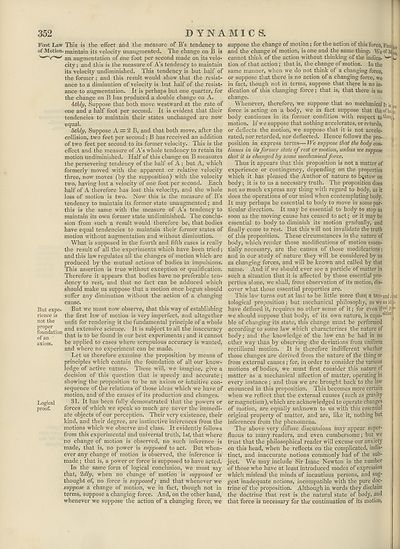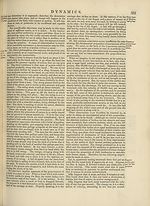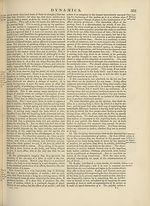Encyclopaedia Britannica > Volume 8, DIA-England
(362) Page 352
Download files
Complete book:
Individual page:
Thumbnail gallery: Grid view | List view

352
DYNAMICS.
First Law This is the effect and the measure of B’s tendency to
of Motion, maintain its velocity unaugmented. The change on B is
an augmentation of one foot per second made on its velo¬
city ; and this is the measure of A’s tendency to maintain
its velocity undiminished. This tendency is but half of
the former; and this result would show that the resist¬
ance to a diminution of velocity is but half of the resist¬
ance to augmentation. It is perhaps but one quarter, for
the change on B has produced a double change on A.
Stilly, Suppose that both move westward at the rate of
one and a half foot per second. It is evident that their
tendencies to maintain their states unchanged are now
equal.
bihly. Suppose A = 2 B, and that both move, after the
collision, two feet per second; B has received an addition
of two feet per second to its former velocity. This is the
effect and the measure of A’s whole tendency to retain its
motion undiminished. Half of this change on B measures
the persevering tendency of the half of A; but A, which
formerly moved with die apparent or relative velocity
three, now moves (by the supposition) with the velocity
two, having lost a velocity of one foot per second. Each
half of A therefore has lost this velocity, and the whole
loss of motion is two. Now this is the measure of B’s
tendency to maintain its former state unaugmented; and
this is the same with the measure of A’s tendency to
maintain its own former state undiminished. The conclu¬
sion from such a result would therefore be, that bodies
have equal tendencies to maintain their former states of
motion without augmentation and without diminution.
What is supposed in the fourth and fifth cases is really
the result of all the experiments which have been tried;
and this law regulates all the changes of motion which are
produced by the mutual actions of bodies in impulsions.
This assertion is true without exception or qualification.
Therefore it appears that bodies have no preferable ten¬
dency to rest, and that no fact can be adduced which
should make us suppose that a motion once begun should
suffer any diminution without the action of a changing
cause.
But expe- But we must now observe, that this way of establishing
rience is the first law of motion is very imperfect, and altogether
not the unfit for rendering it the fundamental principle of a whole
foundation ant^ extensive science. It is subject to all the inaccuracy
of an J ^iat *s t0 be found in our best experiments; and it cannot
axiom. be applied to cases where scrupulous accuracy is wanted,
and where no experiment can be made.
Let us therefore examine the proposition by means of
principles which contain the foundation of all our know¬
ledge of active nature. These will, we imagine, give a
decision of this question that is speedy and accurate;
showing the proposition to be an axiom or intuitive con¬
sequence of the relations of those ideas which we have of
motion, and of the causes of its production and changes.
Logical 31. It has been fully demonstrated that the powers or
proof! forces of which we speak so much are never the immedi¬
ate objects of our perception. Their very existence, their
kind, and their degree, are instinctive inferences from the
motions which we observe and class. It evidently follows
from this experimental and universal truth, ls£, that where
no change of motion is observed, no such inference is
made, that is, no power is supposed to act. But when¬
ever any change of motion is observed, the inference is
made ; that is, a power or force is supposed to have acted.
In the same form of logical conclusion, we must say
that, 2dly, when no change of motion is supposed or
thought of, no force is supposed; and that whenever we
suppose a change of motion, we in fact, though not in
terms, suppose a changing force. And, on the other hand,
whenever we suppose the action of a changing force, we
suppose the change of motion; for the action of this force, Pir8|
and the change of motion, is one and the same thing. We ot'M
cannot think of the action without thinking of the Tndica- ^
tion of that action ; that is, the change of motion. In the
same manner, when we do not think of a changing force,
or suppose that there is no action of a changing force, we
in fact, though not in terms, suppose that there is no in¬
dication of this changing force; that is, that there is no
change.
Whenever, therefore, we suppose that no mechanical It is
force is acting on a body, we in fact suppose that the of In
body continues in its former condition with respect to1'1011;
motion. If we suppose that nothing accelerates, or retards,
or deflects the motion, we suppose that it is not accele¬
rated, nor retarded, nor deflected. Hence follows the pro¬
position in express terms— We suppose that the body con¬
tinues in its former state of rest or motion, unless we suppose
that it is changed by some mechanical force.
Thus it appears that this proposition is not a matter of
experience or contingency, depending on the properties
which it has pleased the Author of nature to bestow on
body; it is to us a necessary truth. The proposition does
not so much express any thing with regard to body, as it
does the operations of our mind when contemplating body.
It may perhaps be essential to body to move in some par¬
ticular direction. It may be essential to body to stop as
soon as the moving cause has ceased to act; or it may be
essential to body to diminish its motion gradually, and
finally come to rest. But this will not invalidate the truth
of this proposition. These circumstances in the nature of
body, which render those modifications of motion essen¬
tially necessary, are the causes of those modifications;
and in our study of nature they will be considered by us
as changing forces, and will be known and called by that
name. And if we should ever see a particle of matter in
such a situation that it is affected by those essential pro¬
perties alone, we shall, from observation of its motion, dis¬
cover what those essential properties are.
This law turns out at last to be little more than a tail-and;
tological proposition; but mechanical philosophy, as we an id
have defined it, requires no other sense of it; for even il'c.al.P
we should suppose that body, of its own nature, is capa-sltl01^
ble of changing its state, this change must be performed
according to some law which characterizes the nature of
body; and the knowledge of the law can be had in no
other way than by observing the deviations from uniform
rectilineal motion. It is therefore indifferent whether
those changes are derived from the nature of the thing or
from external causes; for, in order to consider the various
motions of bodies, we must first consider this nature of
matter as a mechanical affection of matter, operating in
every instance; and thus we are brought back to the law
enounced in this proposition. This becomes more certain
when we reflect that the external causes (such as gravity
or magnetism), which are acknowledged to operate changes
of motion, are equally unknown to us with this essential
original property of matter, and are, like it, nothing but
inferences from the phenomena.
The above very diffuse discussions may appear super¬
fluous to many readers, and even cumbersome; but we
trust that the philosophical reader will excuse our anxiety
on this head, when he reflects on the complicated, indis¬
tinct, and inaccurate notions commonly had of the sub¬
ject. We may include Sir Isaac Newton in the number
of those who have at least introduced modes of expression
which mislead the minds of incautious persons, and sug¬
gest inadequate notions, incompatible with the pure doc¬
trine of the proposition. Although in words they disclaim
the doctrine that rest is the natural state of body, and
that force is necessary for the continuation of its motion,
aw
on.
aw
n
ost
DYNAMICS.
First Law This is the effect and the measure of B’s tendency to
of Motion, maintain its velocity unaugmented. The change on B is
an augmentation of one foot per second made on its velo¬
city ; and this is the measure of A’s tendency to maintain
its velocity undiminished. This tendency is but half of
the former; and this result would show that the resist¬
ance to a diminution of velocity is but half of the resist¬
ance to augmentation. It is perhaps but one quarter, for
the change on B has produced a double change on A.
Stilly, Suppose that both move westward at the rate of
one and a half foot per second. It is evident that their
tendencies to maintain their states unchanged are now
equal.
bihly. Suppose A = 2 B, and that both move, after the
collision, two feet per second; B has received an addition
of two feet per second to its former velocity. This is the
effect and the measure of A’s whole tendency to retain its
motion undiminished. Half of this change on B measures
the persevering tendency of the half of A; but A, which
formerly moved with die apparent or relative velocity
three, now moves (by the supposition) with the velocity
two, having lost a velocity of one foot per second. Each
half of A therefore has lost this velocity, and the whole
loss of motion is two. Now this is the measure of B’s
tendency to maintain its former state unaugmented; and
this is the same with the measure of A’s tendency to
maintain its own former state undiminished. The conclu¬
sion from such a result would therefore be, that bodies
have equal tendencies to maintain their former states of
motion without augmentation and without diminution.
What is supposed in the fourth and fifth cases is really
the result of all the experiments which have been tried;
and this law regulates all the changes of motion which are
produced by the mutual actions of bodies in impulsions.
This assertion is true without exception or qualification.
Therefore it appears that bodies have no preferable ten¬
dency to rest, and that no fact can be adduced which
should make us suppose that a motion once begun should
suffer any diminution without the action of a changing
cause.
But expe- But we must now observe, that this way of establishing
rience is the first law of motion is very imperfect, and altogether
not the unfit for rendering it the fundamental principle of a whole
foundation ant^ extensive science. It is subject to all the inaccuracy
of an J ^iat *s t0 be found in our best experiments; and it cannot
axiom. be applied to cases where scrupulous accuracy is wanted,
and where no experiment can be made.
Let us therefore examine the proposition by means of
principles which contain the foundation of all our know¬
ledge of active nature. These will, we imagine, give a
decision of this question that is speedy and accurate;
showing the proposition to be an axiom or intuitive con¬
sequence of the relations of those ideas which we have of
motion, and of the causes of its production and changes.
Logical 31. It has been fully demonstrated that the powers or
proof! forces of which we speak so much are never the immedi¬
ate objects of our perception. Their very existence, their
kind, and their degree, are instinctive inferences from the
motions which we observe and class. It evidently follows
from this experimental and universal truth, ls£, that where
no change of motion is observed, no such inference is
made, that is, no power is supposed to act. But when¬
ever any change of motion is observed, the inference is
made ; that is, a power or force is supposed to have acted.
In the same form of logical conclusion, we must say
that, 2dly, when no change of motion is supposed or
thought of, no force is supposed; and that whenever we
suppose a change of motion, we in fact, though not in
terms, suppose a changing force. And, on the other hand,
whenever we suppose the action of a changing force, we
suppose the change of motion; for the action of this force, Pir8|
and the change of motion, is one and the same thing. We ot'M
cannot think of the action without thinking of the Tndica- ^
tion of that action ; that is, the change of motion. In the
same manner, when we do not think of a changing force,
or suppose that there is no action of a changing force, we
in fact, though not in terms, suppose that there is no in¬
dication of this changing force; that is, that there is no
change.
Whenever, therefore, we suppose that no mechanical It is
force is acting on a body, we in fact suppose that the of In
body continues in its former condition with respect to1'1011;
motion. If we suppose that nothing accelerates, or retards,
or deflects the motion, we suppose that it is not accele¬
rated, nor retarded, nor deflected. Hence follows the pro¬
position in express terms— We suppose that the body con¬
tinues in its former state of rest or motion, unless we suppose
that it is changed by some mechanical force.
Thus it appears that this proposition is not a matter of
experience or contingency, depending on the properties
which it has pleased the Author of nature to bestow on
body; it is to us a necessary truth. The proposition does
not so much express any thing with regard to body, as it
does the operations of our mind when contemplating body.
It may perhaps be essential to body to move in some par¬
ticular direction. It may be essential to body to stop as
soon as the moving cause has ceased to act; or it may be
essential to body to diminish its motion gradually, and
finally come to rest. But this will not invalidate the truth
of this proposition. These circumstances in the nature of
body, which render those modifications of motion essen¬
tially necessary, are the causes of those modifications;
and in our study of nature they will be considered by us
as changing forces, and will be known and called by that
name. And if we should ever see a particle of matter in
such a situation that it is affected by those essential pro¬
perties alone, we shall, from observation of its motion, dis¬
cover what those essential properties are.
This law turns out at last to be little more than a tail-and;
tological proposition; but mechanical philosophy, as we an id
have defined it, requires no other sense of it; for even il'c.al.P
we should suppose that body, of its own nature, is capa-sltl01^
ble of changing its state, this change must be performed
according to some law which characterizes the nature of
body; and the knowledge of the law can be had in no
other way than by observing the deviations from uniform
rectilineal motion. It is therefore indifferent whether
those changes are derived from the nature of the thing or
from external causes; for, in order to consider the various
motions of bodies, we must first consider this nature of
matter as a mechanical affection of matter, operating in
every instance; and thus we are brought back to the law
enounced in this proposition. This becomes more certain
when we reflect that the external causes (such as gravity
or magnetism), which are acknowledged to operate changes
of motion, are equally unknown to us with this essential
original property of matter, and are, like it, nothing but
inferences from the phenomena.
The above very diffuse discussions may appear super¬
fluous to many readers, and even cumbersome; but we
trust that the philosophical reader will excuse our anxiety
on this head, when he reflects on the complicated, indis¬
tinct, and inaccurate notions commonly had of the sub¬
ject. We may include Sir Isaac Newton in the number
of those who have at least introduced modes of expression
which mislead the minds of incautious persons, and sug¬
gest inadequate notions, incompatible with the pure doc¬
trine of the proposition. Although in words they disclaim
the doctrine that rest is the natural state of body, and
that force is necessary for the continuation of its motion,
aw
on.
aw
n
ost
Set display mode to:
![]() Universal Viewer |
Universal Viewer | ![]() Mirador |
Large image | Transcription
Mirador |
Large image | Transcription
Images and transcriptions on this page, including medium image downloads, may be used under the Creative Commons Attribution 4.0 International Licence unless otherwise stated. ![]()
| Encyclopaedia Britannica > Encyclopaedia Britannica > Volume 8, DIA-England > (362) Page 352 |
|---|
| Permanent URL | https://digital.nls.uk/193327711 |
|---|
| Attribution and copyright: |
|
|---|
| Description | Ten editions of 'Encyclopaedia Britannica', issued from 1768-1903, in 231 volumes. Originally issued in 100 weekly parts (3 volumes) between 1768 and 1771 by publishers: Colin Macfarquhar and Andrew Bell (Edinburgh); editor: William Smellie: engraver: Andrew Bell. Expanded editions in the 19th century featured more volumes and contributions from leading experts in their fields. Managed and published in Edinburgh up to the 9th edition (25 volumes, from 1875-1889); the 10th edition (1902-1903) re-issued the 9th edition, with 11 supplementary volumes. |
|---|---|
| Additional NLS resources: |
|

